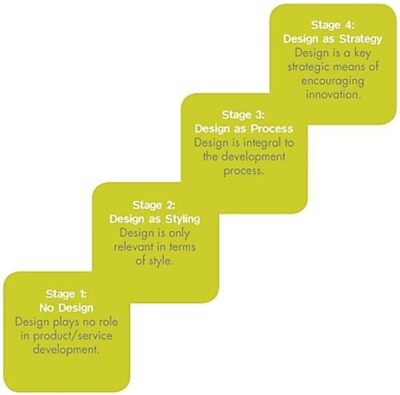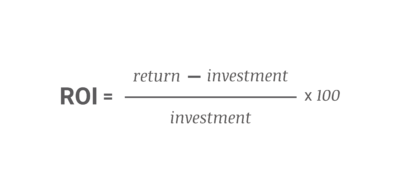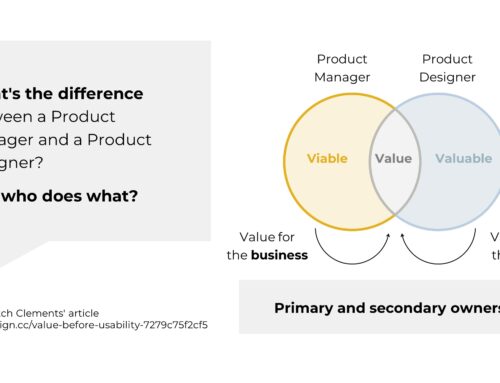A while ago I wrote about the ROI de UX. While that article was more “philosophical” in nature, I will take on a more practical approach here.
But before discussing the ROI of UX, it’s important to remember what we all know but Alan Cooper expressed perfectly in his article, “The ROI of UX”:
If design is just about making screens pretty, we can’t talk about ROI of UX because in this case, design doesn’t provide any value. We can only talk about the ROI of UX when design plays a more strategic role.
In fact, if we look at the design maturity scale in organizations (there are many, but I like the one by the Danish Design Council), we see that if UX is situated on the lower rungs, it doesn’t provide any business value, so we can’t talk about ROI. We can only start thinking about design’s value as we transition to the higher levels.

Danish Design Ladder
Having said all of this, let’s now look at why it is difficult to talk about the ROI of UX.
Why Is It Difficult to Calculate ROI of UX?
Let’s first remember the ROI formula: (Return – Investment) / Investment x 100

One of the first challenges is the attribution or scope we consider when calculating both revenue and investment.
Let’s analyze this assuming a checkout redesign aimed at increasing sales.
The challenge with calculating the Investment
Let’s start with the investment: what do we count as cost?
At first, you’d think it’s simply the “cost” of the UX team (notice the “” around “cost”). But from a purely accounting perspective, do we only consider the salaries of those involved in the project? Or do we also include overhead and other indirect costs?
Moreover, our design won’t yield any results until it is implemented, so should we also include implementation “costs” as part of the total investment?
The challenge with calculating the Return
When calculating revenue, there are two issues to consider:
- Return period: What time frame do we consider?
- Attribution: How do we attribute the return to the project?
Return Period
The return of our investment is cumulative over time. If we improve the checkout flow to boost sales, since not all customers purchase in the same month (depending on the product), we will accrue the benefit over time.
So… how much time should we consider for the revenue calculation? Three months? A year?
And here’s another issue: if it takes three months (let alone a year!) to demonstrate the ROI of our project, by the time we have the numbers, everyone will have forgotten about it.
Attribution
Initially, one could assume that the sales increase can be directly attributed to the checkout redesign, but given that the return period is usually longer than a month (following the example above we could consider 3 months) things get complicated.
What if during these three months we launched a promotion that boosts sales, or new features that make the product more attractive? While the new design may have amplified the effects of a promotion, it’s not solely responsible for the sales increase.
When Do We Calculate ROI?
The timing of the ROI calculation alters many of the considerations mentioned earlier.
If we calculate it after the project, we face all the problems related to revenue attribution that we just mentioned.
But if we calculate it beforehand, the problem is much simpler because we’re merely estimating the revenue. This means it’s no longer an ROI calculation but a projection of the project’s benefits. Many of the variables we previously mentioned are no longer problematic.
Alternatives to the ROI of UX
The difficulty in calculating the ROI of UX doesn’t mean we can’t measure the impact of design. In fact, it’s critical to do so.
There are two main ways to approach this: link design decisions to
- key product or business metrics
- financial outcomes
The first method involves determining how design decisions impact key product and business indicators, aligning UX decisions with business strategy.
The second approach focuses on understanding how design decisions affect the company’s financial results.
For a company, improving results means either making more money or saving costs (which ultimately leads to making more money). So this way of measuring the impact of design means understanding how design helps gain more money and/or reduce costs.
Metrics that UX Design can impact
Here are some metrics that UX teams can try to connect to their work. However, note that this list is indicative, as the metrics impacted will depend on the project:
- Conversion: How does the experience improve conversions? Bear in mind that conversion isn’t always about sales; it’s defined as achieving an important business goal (downloading material, completing a form, etc.).
- Retention and churn: How does the experience help retain customers (or reduce churn)?
- CLTV (Customer Lifetime Value): How does the experience contribute to greater customer profitability over time, and how does it make this relationship more durable?
- Engagement: How does design help customers make better use of the product? Note that I’m not referring to engagement as “more time spent on the site,” as this doesn’t necessarily correlate with increased interest, but to helping customers get more value from the product.
- Cost reduction: Reduced support costs, fewer complaints, more issues resolved via self-service, etc.
- Faster time-to-value
- Loyalty: Increased visit frequency, purchase recurrence, amount spent, number of products bought.
- CAC (Customer Acquisition Cost): Better experiences reduce the cost of acquiring new customers.
- Market share
- Customer testimonials: More positive testimonials, fewer negative comments.
IMPORTANT!
To effectively measure the impact of design on product performance and business results, there’s something crucial that’s often missing: objectives.
Before starting a new design project we must have clear objectives: why are we doing this? What result do we expect?
In other words, before moving a pixel on the screen, we need to know why we’re moving it.
If we don’t know why we’re doing what we’re doing, there’s no way to measure the result—simply because we won’t know what to measure.
In Summary
Calculating the ROI of UX is complex. It’s challenging to determine the scope of costs: what do we include? What do we leave out? But even more difficult is calculating the revenue as it’s hard to isolate the impact of UX from the other variables that contribute to increased revenue. Rarely are revenues the direct result of a single activity.
However, the impact of design is something the must and should be calculated, and we can do this by linking design decisions to key product or business metrics, or to financial outcomes. Or both.
But to effectively measure the impact of design on product performance and business results, every project must have a clearly stated goal: what are we trying to achieve? what is the expected impact? If we don’t have a goal we won’t be able to measure any impact.
A while ago I wrote about the ROI de UX. While that article was more “philosophical” in nature, I will take on a more practical approach here.
But before discussing the ROI of UX, it’s important to remember what we all know but Alan Cooper expressed perfectly in his article, “The ROI of UX”:
If design is just about making screens pretty, we can’t talk about ROI of UX because in this case, design doesn’t provide any value. We can only talk about the ROI of UX when design plays a more strategic role.
In fact, if we look at the design maturity scale in organizations (there are many, but I like the one by the Danish Design Council), we see that if UX is situated on the lower rungs, it doesn’t provide any business value, so we can’t talk about ROI. We can only start thinking about design’s value as we transition to the higher levels.

Danish Design Ladder
Having said all of this, let’s now look at why it is difficult to talk about the ROI of UX.
Why Is It Difficult to Calculate ROI of UX?
Let’s first remember the ROI formula: (Return – Investment) / Investment x 100

One of the first challenges is the attribution or scope we consider when calculating both revenue and investment.
Let’s analyze this assuming a checkout redesign aimed at increasing sales.
The challenge with calculating the Investment
Let’s start with the investment: what do we count as cost?
At first, you’d think it’s simply the “cost” of the UX team (notice the “” around “cost”). But from a purely accounting perspective, do we only consider the salaries of those involved in the project? Or do we also include overhead and other indirect costs?
Moreover, our design won’t yield any results until it is implemented, so should we also include implementation “costs” as part of the total investment?
The challenge with calculating the Return
When calculating revenue, there are two issues to consider:
- Return period: What time frame do we consider?
- Attribution: How do we attribute the return to the project?
Return Period
The return of our investment is cumulative over time. If we improve the checkout flow to boost sales, since not all customers purchase in the same month (depending on the product), we will accrue the benefit over time.
So… how much time should we consider for the revenue calculation? Three months? A year?
And here’s another issue: if it takes three months (let alone a year!) to demonstrate the ROI of our project, by the time we have the numbers, everyone will have forgotten about it.
Attribution
Initially, one could assume that the sales increase can be directly attributed to the checkout redesign, but given that the return period is usually longer than a month (following the example above we could consider 3 months) things get complicated.
What if during these three months we launched a promotion that boosts sales, or new features that make the product more attractive? While the new design may have amplified the effects of a promotion, it’s not solely responsible for the sales increase.
When Do We Calculate ROI?
The timing of the ROI calculation alters many of the considerations mentioned earlier.
If we calculate it after the project, we face all the problems related to revenue attribution that we just mentioned.
But if we calculate it beforehand, the problem is much simpler because we’re merely estimating the revenue. This means it’s no longer an ROI calculation but a projection of the project’s benefits. Many of the variables we previously mentioned are no longer problematic.
Alternatives to the ROI of UX
The difficulty in calculating the ROI of UX doesn’t mean we can’t measure the impact of design. In fact, it’s critical to do so.
There are two main ways to approach this: link design decisions to
- key product or business metrics
- financial outcomes
The first method involves determining how design decisions impact key product and business indicators, aligning UX decisions with business strategy.
The second approach focuses on understanding how design decisions affect the company’s financial results.
For a company, improving results means either making more money or saving costs (which ultimately leads to making more money). So this way of measuring the impact of design means understanding how design helps gain more money and/or reduce costs.
Metrics that UX Design can impact
Here are some metrics that UX teams can try to connect to their work. However, note that this list is indicative, as the metrics impacted will depend on the project:
- Conversion: How does the experience improve conversions? Bear in mind that conversion isn’t always about sales; it’s defined as achieving an important business goal (downloading material, completing a form, etc.).
- Retention and churn: How does the experience help retain customers (or reduce churn)?
- CLTV (Customer Lifetime Value): How does the experience contribute to greater customer profitability over time, and how does it make this relationship more durable?
- Engagement: How does design help customers make better use of the product? Note that I’m not referring to engagement as “more time spent on the site,” as this doesn’t necessarily correlate with increased interest, but to helping customers get more value from the product.
- Cost reduction: Reduced support costs, fewer complaints, more issues resolved via self-service, etc.
- Faster time-to-value
- Loyalty: Increased visit frequency, purchase recurrence, amount spent, number of products bought.
- CAC (Customer Acquisition Cost): Better experiences reduce the cost of acquiring new customers.
- Market share
- Customer testimonials: More positive testimonials, fewer negative comments.
IMPORTANT!
To effectively measure the impact of design on product performance and business results, there’s something crucial that’s often missing: objectives.
Before starting a new design project we must have clear objectives: why are we doing this? What result do we expect?
In other words, before moving a pixel on the screen, we need to know why we’re moving it.
If we don’t know why we’re doing what we’re doing, there’s no way to measure the result—simply because we won’t know what to measure.
In Summary
Calculating the ROI of UX is complex. It’s challenging to determine the scope of costs: what do we include? What do we leave out? But even more difficult is calculating the revenue as it’s hard to isolate the impact of UX from the other variables that contribute to increased revenue. Rarely are revenues the direct result of a single activity.
However, the impact of design is something the must and should be calculated, and we can do this by linking design decisions to key product or business metrics, or to financial outcomes. Or both.
But to effectively measure the impact of design on product performance and business results, every project must have a clearly stated goal: what are we trying to achieve? what is the expected impact? If we don’t have a goal we won’t be able to measure any impact.




